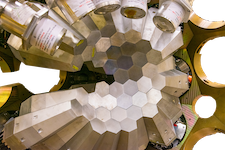Speaker
Description
The aim of this work is an investigation of the structural evolution
in neutron rich nuclei ``south and south-east'' of doubly-magic $^{48}$Ca,
especially with respect to rapidly changing nuclear properties. Here, we want
to investigate $^{46}$Ar, $^{48}$Ar and neighboring odd-A $^{47}$Ar and
$^{49}$K that are accessible in the same experiment. We will deduce unique
structural information from absolute transition strengths determined from
level lifetimes that will be measured with the Recoil Distance Doppler-shift
technique employing a new Cologne compact plunger device coupled to AGATA
and PRISMA and employing multinucleon transfer reactions. The investigation
of this region is particular interest: These nuclei are located along the
path from doubly magic $^{48}$Ca to collective nuclei, e.g., neutron-rich S
and Si isotopes. Especially, an erosion of the N=28 shell closure is in the
focus of this work. Such was observed in lighter isotopes in this region,
but sparse and partly ambiguous data exists for neutron rich argon isotopes
so far, even though newer results support a weakening of the N=28 closure
already in argon. Thus this region is critical for the understanding of shell
evolution and structural changes where
shell model descriptions already turned out to be a challenge. Further, recent
experimental findings in the neutron-rich Ti isotopes, which are valence
proton partners for Ar with respect to Z=20, also give evidence for rapid
structural changes for increasing neutron number. The results of this work
will allow to judge a possible valence proton symmetry with respect to Z=20.

